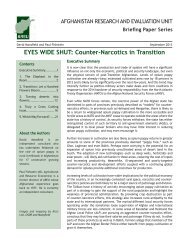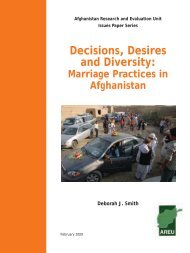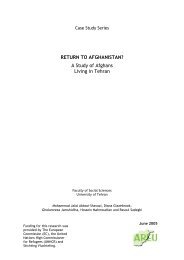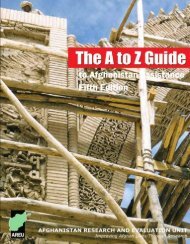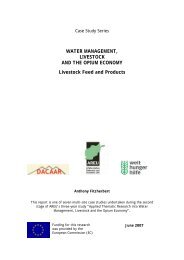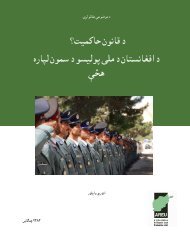Local Governance in Afghanistan: A View from the Ground
Local Governance in Afghanistan: A View from the Ground
Local Governance in Afghanistan: A View from the Ground
- No tags were found...
Create successful ePaper yourself
Turn your PDF publications into a flip-book with our unique Google optimized e-Paper software.
<strong>Afghanistan</strong> Research and Evaluation Unit<br />
2011<br />
9. Conclusion<br />
The first aspect emerg<strong>in</strong>g <strong>from</strong> this research is <strong>the</strong> need for much greater realism <strong>in</strong> <strong>the</strong> def<strong>in</strong>ition<br />
and function of local government. <strong>Local</strong> government is composed of three elements: adm<strong>in</strong>istration,<br />
<strong>the</strong> judiciary, and representative <strong>in</strong>stitutions. The operation of adm<strong>in</strong>istration and service delivery is<br />
highly centralised and subject to a range of distortions. The judiciary suffers <strong>from</strong> much corruption.<br />
The representative <strong>in</strong>stitutions have few rights beyond those of consultation and recommendation.<br />
The development of viable and reflexive local government will require political will and action <strong>in</strong><br />
each of <strong>the</strong>se areas. In addition, <strong>the</strong> build<strong>in</strong>g of representative <strong>in</strong>stitutions will require resources to<br />
build capacity, provide adm<strong>in</strong>istrative support and supply modest facilities. Fur<strong>the</strong>rmore, <strong>the</strong> Afghan<br />
government must address <strong>the</strong>se issues if it is to streng<strong>the</strong>n public support and cohesion. Failure to do<br />
so will cont<strong>in</strong>ue to underm<strong>in</strong>e its political base and fur<strong>the</strong>r encourage Taliban recruitment occurr<strong>in</strong>g<br />
as a result of official malfeasance. 153<br />
The second important feature is <strong>the</strong> need to develop public understand<strong>in</strong>g of <strong>Afghanistan</strong>’s evolv<strong>in</strong>g<br />
state structures and <strong>the</strong> ideas that underp<strong>in</strong> <strong>the</strong>m. It is no longer feasible for communities to be<br />
as self-conta<strong>in</strong>ed as <strong>the</strong>y have been <strong>in</strong> <strong>the</strong> past. As <strong>the</strong> state becomes a more established feature,<br />
people’s lives will be transformed, as is already start<strong>in</strong>g to be <strong>the</strong> case through education, better<br />
health care, improved communication and economic development. However, Afghans are generally<br />
cautious and conservative, and with good reason. As noted <strong>in</strong> Section 2.1, <strong>the</strong> public are currently<br />
caught between <strong>the</strong> three compet<strong>in</strong>g agendas of <strong>the</strong> <strong>in</strong>ternational community, <strong>the</strong> government and<br />
<strong>the</strong> Taliban, and are quite rightly unsure of whom <strong>the</strong>y can trust. This new form of government<br />
<strong>in</strong>trudes upon <strong>the</strong>ir lives <strong>in</strong> novel ways, by no means all of which are seen as positive. The degree of<br />
corruption is alienat<strong>in</strong>g many. If <strong>the</strong> public is to engage with government <strong>the</strong>re is a need for better<br />
public understand<strong>in</strong>g of what government is, what it seeks to achieve and how. While people are<br />
well versed <strong>in</strong> understand<strong>in</strong>g <strong>the</strong> <strong>in</strong>terplay of tribal, ethnic, party and personality politics, <strong>the</strong>re is<br />
little knowledge about government hierarchies, <strong>the</strong> notion of democracy, <strong>the</strong> nature of rights and<br />
<strong>the</strong> way that programmes are selected and organised. Fur<strong>the</strong>rmore, when set aga<strong>in</strong>st a background<br />
of corruption, cont<strong>in</strong>ued <strong>in</strong>security and <strong>the</strong> <strong>in</strong>fluence of foreigners, <strong>the</strong>se features are often seen<br />
<strong>in</strong> negative light. Communication and <strong>the</strong> development of public understand<strong>in</strong>g is <strong>the</strong>refore of <strong>the</strong><br />
utmost importance. The establishment of effective local government structures has <strong>the</strong> potential<br />
to play a part <strong>in</strong> this, as long as <strong>the</strong>y are given appropriate levels of responsibility and resources.<br />
Many found what was happen<strong>in</strong>g opaque and not readily understood by virtue of its complexity.<br />
Explanations are needed, and for this to take place communication has to be substantially improved.<br />
Thirdly, given levels of political will, resources and public understand<strong>in</strong>g, <strong>the</strong>re is a need for time. If<br />
it is to happen, <strong>the</strong> transformation of local governance will not occur overnight. The <strong>in</strong>itial mapp<strong>in</strong>g<br />
out of changes to <strong>the</strong> system will be complex and fraught with <strong>the</strong> tension aris<strong>in</strong>g <strong>from</strong> compet<strong>in</strong>g<br />
demands and fear of <strong>the</strong> loss of central control. There will be many difficulties that will need to be<br />
overcome. However, once a clear, consensual and comprehensible strategy is established, <strong>the</strong>n steps<br />
can be taken to build greater capacity and responsive structures capable of generat<strong>in</strong>g public trust.<br />
Crucially, noth<strong>in</strong>g can be achieved at <strong>the</strong> pace currently be<strong>in</strong>g dictated by <strong>the</strong> West, which is press<strong>in</strong>g<br />
systems beyond <strong>the</strong>ir capacity to respond and deliver.<br />
Evidence <strong>from</strong> this study demonstrates <strong>the</strong> existence of a complex social order that has shown itself<br />
capable of ma<strong>in</strong>ta<strong>in</strong><strong>in</strong>g cohesion through <strong>the</strong> recent waves of development, whe<strong>the</strong>r structured by<br />
<strong>the</strong> PDPA, <strong>the</strong> Soviets, <strong>the</strong> Taliban or <strong>the</strong> present phase of external donor support. While governance<br />
rema<strong>in</strong>s diffuse, diverse and fragmented, it is by virtue of <strong>the</strong>se features that Afghan society has been<br />
able to ma<strong>in</strong>ta<strong>in</strong> a measure of stability amid frequent changes <strong>in</strong> regime and ideology. Never<strong>the</strong>less,<br />
society and expectations are chang<strong>in</strong>g as a result of <strong>the</strong> impact of migration, communications,<br />
<strong>in</strong>frastructure development and technology. In <strong>the</strong> context of a modernis<strong>in</strong>g world and whatever <strong>the</strong><br />
outcomes of <strong>the</strong> present conflict, future Afghan governments will require structures that enable <strong>the</strong>m<br />
153 Lakhdar Brahimi and Thomas R. Picker<strong>in</strong>g, <strong>Afghanistan</strong> Negotiat<strong>in</strong>g Peace: The Report of The Century Foundation<br />
International Task Force on <strong>Afghanistan</strong> <strong>in</strong> Its Regional and Multilateral Dimensions (New York: The Century Foundation Press,<br />
2011), 65, 78.<br />
<strong>Local</strong> <strong>Governance</strong> <strong>in</strong> <strong>Afghanistan</strong>: A <strong>View</strong> <strong>from</strong> <strong>the</strong> <strong>Ground</strong><br />
72



